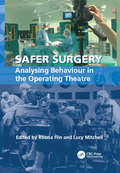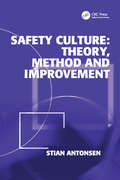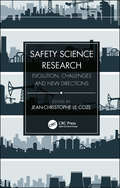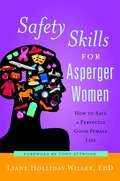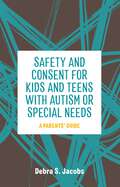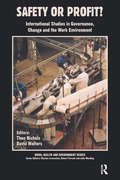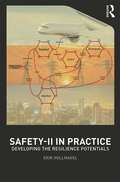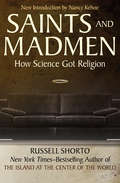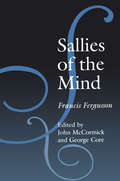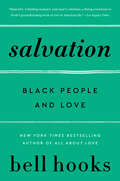- Table View
- List View
Safer Sex in Personal Relationships: The Role of Sexual Scripts in HIV Infection and Prevention (LEA's Series on Personal Relationships)
by Mike Allen Tara M. Emmers-SommerThis book focuses on safer sex discussion and practice in close, personal relationships, emphasizing research on individuals in personal relationship types that are experiencing a rise in HIV infection and AIDS. Moving beyond studies of gay adult males and IV drug-users, this work paints a clear picture of the very real risk that exists for these less-studied, more general populations, so individuals may better personalize the risk and engage in more preventative measures. Authors Tara M. Emmers-Sommer and Mike Allen examine issues surrounding safer sex, utilizing research that focuses on how individuals struggle with personalizing the HIV and AIDS risk and how they cope with safer sex issues.Safer Sex in Personal Relationships takes readers on a journey through a variety of close relationship types. It begins by highlighting awareness to the global enormity of HIV and AIDS and providing a link between the global and personal, and the need to make HIV and AIDS awareness part of everyday talk and personal relationship structure. It then focuses on:*safer sex in close relationships, both heterosexual and homosexual;*marital relationships and the importance of safe sex discussion and awareness in marriages;*HIV and AIDS from a multicultural perspective;*HIV and AIDS in aged populations; and*increasing awareness, understanding, and compassion of those living with HIV and AIDS.This book will appeal to scholars and students concerned with HIV and AIDS in personal relationships. It will be an invaluable text for courses on interpersonal communication and relationships; family, marital, human sexuality, sex and gender, gay and lesbian relationships, and sexual education; and relational conflict across communication, psychology, and sociology disciplines.
Safer Surgery: Analysing Behaviour in the Operating Theatre
by Lucy Mitchell Rhona FlinOperating theatres are very private workplaces. There have been few research investigations into how highly trained doctors and nurses work together to achieve safe and efficient anaesthesia and surgery. While there have been major advances in surgical and anaesthetic procedures, there are still significant risks for patients during operations and adverse events are not unknown. Due to rising concern about patient safety, surgeons and anaesthetists have looked for ways of minimising adverse events. Behavioural scientists have been encouraged by clinicians to bring research techniques used in other industries into the operating theatre in order to study the behaviour of surgeons, nurses and anaesthetists. Safer Surgery presents one of the first collections of studies designed to understand the factors influencing safe and efficient surgical, anaesthetic and nursing practice. The book is written by psychologists, surgeons and anaesthetists, whose contributions combine to offer readers the latest research techniques and findings from some of the leading investigators in this field. It is designed for practitioners and researchers interested in understanding the behaviour of operating theatre team members, with a view to enhancing both training and practice. The material is also suitable for those studying behaviour in other areas of healthcare or in high-risk work settings. The aims of the book are to: a) present the latest research on the behaviour of operating theatre teams b) describe the techniques being used by psychologists and clinicians to study surgeons, anaesthetists and theatre nurses' task performance c) outline the safety implications of the research to date.
Safety Culture: Theory Method And Improvement
by Stian AntonsenThe aim of this book is to show how a cultural approach can contribute to the assessment, description and improvement of safety conditions in organizations. The relationship between organizational culture and safety, epitomized through the concept of 'safety culture', has undoubtedly become one of the hottest topics of both safety research and practical efforts to improve safety. By combining a general framework and five research projects, the author explores and further develops the theoretical, methodological and practical basis of the study of safety culture. What are the theoretical foundations of a cultural approach to safety? How can the relationship between organizational culture and safety be empirically investigated? What are the links between organizational culture and safety in actual organizations? How can a cultural approach contribute to the improvement of safety? These are the key questions the book seeks to answer with a unified and in-depth account of the concept of safety culture.
Safety Science Research: Evolution, Challenges and New Directions
by Jean-Christophe Le CozeSafety Science Research: Evolution, Challenges and New Directions provides a unique perspective into the latest developments of safety science by putting together, for the first time, a new generation of authors with some of the pioneers of the field. Forty years ago, research traditions were developed, including, among others, high-reliability organisations, cognitive system engineering or safety regulations. In a fast-changing world, the new generation introduces, in this book, new disciplinary insights, addresses contemporary empirical issues, develops new concepts and models while remaining critical of safety research practical ambitions. Their ideas are then reflected and discussed by some of the pioneers of safety science. Features Allows the reader to discover how contemporary safety issues are currently framed by a new generation of researchers, brought together for the first time Includes an introduction and guide to the development of safety science over the last four decades Features an extraordinary collection of expert contributors, including pioneers of safety research, reflecting the evolution of the discipline and offering insightful commentary on the current and future state of the field Serves as an invaluable reference and guide for safety professionals and students from any established disciplines such as sociology, engineering, psychology, political science or management as well as dedicated safety programmes Some figures in the eBook are in colour
Safety Skills for Asperger Women: How to Save a Perfectly Good Female Life
by Tony Attwood Liane Holliday WilleyLife with Asperger's Syndrome can be a challenge at the best of times, and trials and tribulations that neurotypicals take in their stride can leave Aspies perplexed and unsure of how best to solve problems and keep themselves safe, both physically and emotionally. This book explores difficulties that those with AS may face, and suggests practical and helpful ways of overcoming them. Liane Holliday Willey's positive and encouraging advice teaches people with Asperger Syndrome how to appreciate their differences and work from their strengths, by being honest about and coping with challenges. By setting realistic expectations, she shows how it can be possible to live on your own and take care of yourself, touching upon everything from banking and housing to roommates, friendships, and relationships. Jobs and the workplace are explored as advice is given on interviewing, performance, and getting along with colleagues, and the importance of setting boundaries is explained. The focus throughout is on keeping yourself safe, and this extends to travel, cultural awareness, and generally organising yourself. Personal hygiene and the body are also covered, along with nutrition and illness. The advice all adds up to show that people with AS can safeguard themselves from emotional and physical harm and live happy and independent lives, as long as the right guidance is available. This book will be of interest to people with Asperger Syndrome, their friends and families, and professionals working alongside ASDs.
Safety and Consent for Kids and Teens with Autism or Special Needs: A Parents' Guide
by Debra JacobsThe developmental challenges of children with special needs means they are often more at risk of physical or emotional exploitation. This book provides invaluable tools to help parents, carers and teachers protect vulnerable children. Difficult topics are sensitively and straightforwardly addressed through step-by-step guidelines for parents and learning activities for children.Guidance to carers includes information on how to identify warning signs of abuse, and recognise tell-tale behaviour changes in their child. Intervention activities help children learn which adults to trust and how to stay safe, while reducing the fear, shame or stigma surrounding abuse. Aimed at ages 5-12, these learning devices have been specifically designed to meet a range of comprehension and developmental abilities, with instructions for parents to adapt them to meet the specific needs of their child.This important guidebook empowers adults to fulfil their responsibility to protect and support children, and to provide a safe environment in which every child can reach their highest potential free from coercion or abuse.
Safety or Profit?: International Studies in Governance, Change and the Work Environment (Work, Health and Environment Series)
by David Walters Theo NicholsAs the title Safety or Profit? suggests, health and safety at work needs to be understood in the context of the wider political economy. This book brings together contributions informed by this view from internationally recognized scholars. It reviews the governance of health and safety at work, with special reference to Australia, Canada, Sweden, and the United Kingdom. Three main aspects are discussed. The restructuring of the labor market: this is considered with respect to precarious work and to gender issues and their implications for the health and safety of workers. The neoliberal agenda: this is examined with respect to the diminished power of organized labor, decriminalization, and new governance theory, including an examination of how well the health-and-safety-at-work regimes put in place in many industrial societies about forty years ago have fared and how distinctive the recent emphasis on self-regulation in several countries really is. The role of evidence: there is a dearth of evidence-based policy. The book examines how policy on health and safety at work is formulated at both company and state levels. Cases considered include the scant regard paid to evidence by an official inquiry into future strategy in Canada; the lack of evidence-based policy and the reluctance to observe the precautionary principle with respect to work-related cancer in the United Kingdom; and the failure to learn from past mistakes in the Deepwater Horizon disaster in the Gulf of Mexico.
Safety, Danger, and Protection in the Family and Community: A Systemic and Attachment-Informed Approach
by Arlene Vetere Szymon ChrząstowskiThis book provides an analysis of the meaning of safety and security across the contexts of community and public life, throughout the life span, and within a therapeutic framework, examining threats and the strategies for coping with them. The book starts in Part I with a discussion of general safety and security concepts in the socio-cultural context. Part II of the book details the role of a sense of security in psychological assistance, psychotherapy and supervision, while Part III centres on safety and security at different life stages. Drawing on the tenets of modern attachment theory and trauma theory, chapter authors address questions of safety, danger, and protection for both individuals and groups, across a variety of fields of knowledge and expertise. Themes such as loneliness, play and exploration, evil and forgiveness, health and death, and spirituality and healing are discussed as practice examples, learning points, and tips. A wide range of health and social care professional practitioners will find this book useful in exploring social, interpersonal, and psychological aspects of safety and security.
Safety-II in Practice: Developing the Resilience Potentials
by Erik HollnagelSafety-I is defined as the freedom from unacceptable harm. The purpose of traditional safety management is therefore to find ways to ensure this ‘freedom’. But as socio-technical systems steadily have become larger and less tractable, this has become harder to do. Resilience engineering pointed out from the very beginning that resilient performance - an organisation’s ability to function as required under expected and unexpected conditions alike – required more than the prevention of incidents and accidents. This developed into a new interpretation of safety (Safety-II) and consequently a new form of safety management. Safety-II changes safety management from protective safety and a focus on how things can go wrong, to productive safety and a focus on how things can and do go well. For Safety-II, the aim is not just the elimination of hazards and the prevention of failures and malfunctions but also how best to develop an organisation’s potentials for resilient performance – the way it responds, monitors, learns, and anticipates. That requires models and methods that go beyond the Safety-I toolbox. This book introduces a comprehensive approach for the management of Safety-II, called the Resilience Assessment Grid (RAG). It explains the principles of the RAG and how it can be used to develop the resilience potentials. The RAG provides four sets of diagnostic and formative questions that can be tailored to any organisation. The questions are based on the principles of resilience engineering and backed by practical experience from several domains. Safety-II in Practice is for both the safety professional and academic reader. For the professional, it presents a workable method (RAG) for the management of Safety-II, with a proven track record. For academic and student readers, the book is a concise and practical presentation of resilience engineering.
Sag mal: Worauf es bei der Moderation von Gruppen ankommt (Psychologie für Studium und Beruf)
by Heidrun Schüler-Lubienetzki Ulf LubienetzkiLernen Sie in diesem anschaulichen Lehrbuch die Grundlagen und Techniken einer besonderen Form der Gesprächsführung kennen: der Moderation. Erfahren Sie, wie Moderation die Kommunikation und Zusammenarbeit in Gruppen unterstützt und die in der Gruppe vorhandenen Potenziale freisetzt.
Sailing Home
by Norman FischerHomer's Odyssey has a timeless allure. It is an ancient story that is significant for every generation: the struggle of a homesick, battle-weary man longing to return to love and family. Odysseus's strivings to overcome divine and earthly obstacles and to control his own impulsive nature hold valuable lessons for people facing their own metaphorical battles and everyday conflicts -- people who are, like Odysseus, "heartsick on the open sea," whether from dealing with daily skirmishes at the office or from fighting in an international war. Sailing Home breathes fresh air into a classic we thought we knew, revealing its profound guidance for navigating life's pitfalls, perils, and spiritual challenges. Norman Fischer deftly incorporates Buddhist, Judaic, Christian, and popular thought, as well as his own unique and sympathetic understanding of life, in his reinterpretation of Odysseus's familiar wanderings as lessons that everyone can use. We see how to resist the seduction of the Sirens' song to stop sailing and give up; how to bide our time in a situation and wait for the right opportunity -- as Odysseus does when faced with the murderous, one-eyed Cyclops; and how to reassess our story and rediscover our purpose and identity if, like the Lotus-Eaters, we have forgotten the past. With meditations that yield personal revelations, illuminating anecdotes from Fischer's and his students' lives, and stories from many wisdom traditions, Sailing Home shows the way to greater purpose in your own life.You will learn a new way to view your path, when to wait and when to act, when to speak your mind and when to exercise discretion, how to draw on your innate strength and distinguish between truth and deception, and how to deal with aging and changing relationships. Sailing Home provides the courage you need for your journey, to renew bonds with your loved ones, and to make the latter portion of life a heartfelt time of spirit and love, so that -- just as Odysseus does -- you can defeat the forces of entropy and death.
Saint Joan of New York: A Novel About God and String Theory (Science and Fiction)
by Mark AlpertSAINT JOAN OF NEW YORK is a novel about a math prodigy who becomes obsessed with discovering the Theory of Everything. Joan Cooper, a 17-year-old genius traumatized by the death of her older sister, tries to rebuild her shattered world by studying string theory and the efforts to unify the laws of physics. But as she tackles the complex equations, she falls prey to disturbing visions of a divine being who wants to help her unveil the universe’s mathematical design. Joan must enter the battle between science and religion, fighting for her sanity and a new understanding of the cosmos.
Saints and Madmen: How Science Got Religion
by Russell ShortoFrom the New York Times–bestselling author: &“Each chapter . . . offers a window on a different intersection of psychiatry and spirituality&” (New Age). In Saints and Madmen, bestselling author Russell Shorto explains how modern science is beginning to reconcile centuries of religious experiences with current psychiatric theories. Psychotic patients sometimes believe they&’re developing mystical powers, speaking to animals or conversing with God during their episodes. As one patient said, psychosis can be life&’s greatest joy, and also its worst hell. Traditional psychiatry has approached the existence of these occurrences as a treatable medical problem, a case of unbalanced chemicals in the brain. But could it be more? In Saints and Madmen, Shorto writes about the scientists who reject the Freudian view of religious experience as narrow-minded, and shows us how their findings could change how we understand our own minds and spirits.
Saints and Rogues: Conflicts and Convergence in Psychotherapy
by E Mark Stern Robert B MarchesaniHelp your clients successfully integrate the angel and the rebel! Saints and Rogues: Conflicts and Convergence in Psychotherapy is a unique look at two extremes of human behavior and thought-and how they meet within the psychotherapy experience. In this extensive resource, you will gain a greater understanding of human potential by exploring personalities where the line between conformity and divergence has been blurred. This book will help psychotherapists, pastoral and marriage and family counselors, and medical/nursing service providers guide patients and clients in turning negative actions and decisions into positive ones. In Saints and Rogues, you will find: an assessment of the life of Harry Stack Sullivan (1892-1949)- called "rogue therapist" by his peers; today a hero for his influence on psychotherapy practice bullying in school-the creation of a prevention program used at the K-5 level designed to appeal to the empathy of the children who are bullied as well as the perpetrators an examination of historical, sociological, and psychoanalytic research about Italian Americans stereotyped as rogues during the twentieth century and in the media today interviews with individuals self-identified as "third gender" who live as neither men nor women-and their frequent encounters with spirituality and much more! Saints and Rogues: Conflicts and Convergence in Psychotherapy reevaluates the ethical ramifications of dual/duel relationships, revealing how a roguish character may be seen as saintly and vice versa. This book emphasizes the importance of seeing and treating one another with the same consideration as we would give ourselves. If knowledge is power, the reader-therapist and layperson alike-will find strength in these pages to face their home, work, or school lives with more confidence and pride.
Saints, Scholars and Schizophrenics: Mental Illness in Rural Ireland
by Nancy Scheper-HughesNancy Scheper-Hughes' classic ethnographic study of schizophrenia in western Ireland.
Salivary Bioscience: Foundations of Interdisciplinary Saliva Research and Applications
by Douglas A. Granger Marcus K. TaylorThis book provides the first comprehensive overview of the emerging field of interdisciplinary salivary bioscience. It serves as a foundational reference guide to the collection, analysis, and interpretation of salivary data, as well as its myriad applications in medicine, surveillance and public health. The ease and non-invasive nature of saliva collection makes it highly useful in diverse fields such as pediatrics, dentistry, neuroscience, psychology, animal welfare and precision medicine. This book introduces students and scientists alike to the vast potential of salivary bioscience in both research and practice.
Sallies of the Mind
by Francis FergussonFrancis Fergusson was one of the foremost American literary critics and scholars of the twentieth century. A man of the theater as well as a man of letters, Fergusson's versatility and mastery traversed a wide range of intellectual disciplines. As George Core notes: "one of the most remarkable aspects of Fergusson's criticism is that it stands comfortably, at ease, with the best work stemming from diverse schools of criticism that are sometimes in conflict—the New Critics, the New York intellectuals, the myth critics and various distinguished critics of the modern theater." Though allied with the New Critics, Fergusson was intellectually capacious enough to be associated with many critical schools of vastly different persuasions. R.W.B. Lewis once remarked of this respected original that "his critical theories and practices possess a severely beautiful purity."Sallies of the Mind is a collection of Fergusson's essays drawn from a variety of virtually unattainable works. It incorporates Fergusson's representative criticism on such major authors as Dante, Shakespeare, James, and Eliot; on myths as well as action; on the modern stage; and on the modern novel. Essays in this collection include: "T.S. Eliot and His Impersonal Theory of Art" "Humanism" "Maritain's Creative Intuition" "Two Perspectives on European Literature" "Two Acts from Dante's Drama of the Mind" "The Divine Comedy as a Bridge across Time" "Hamlet" "Measure for Measure" "Eugene O'Neill" "Exiles and Ibsen's Work" "Oedipus According to Freud, Sophocles, and Freud" "The Theater of Paul Valery" "D.H. Lawrence's Sensibility" and "The Drama in The Golden Bowl."Francis Fergusson's criticism endures not only owing to its originality, depth, and range but also to its classically austere clarity of style. Looking at the present-day critical scene, we see few who match Fergusson's intelligence, learning, and verve. Sallies of the Mind is a tribute to his legacy as well as to the themes he treats.
Salome’s Embrace: The Jungian Women
by Maggy AnthonyC. G. Jung, a man who accomplished a revolution in analytical psychology and made an impact both directly and indirectly on a great number of people, also took women seriously. The release of The Red Book has greatly added to our knowledge of Jung’s relationship with the feminine: from his mother, his wife and his extramarital affairs to the effect these had on the formulation of his psychology and on the women who had the courage to explore the need for a spiritual link to Jung and who became known as the Valkyries. In this revised and expanded study of the many women in Jung’s close circle, Anthony explores the women who followed Jung during his lifetime, his need for their company, and their contributions to his work. The book includes studies of Emma Jung, Sabina Spielrein and Toni Wolff, as well as Jung’s mother Emilie, and many other collaborators and followers. It also includes chapters on The Red Book, the Zurich Psychological Club and Dadaism. Including never-before published primary material, including interviews with the women themselves, Salome’s Embrace assesses their work and its value for the generations of Jungian analysts that have followed, including women who practice depth psychology today. The book will be of great interest to analytical psychologists and Jungian psychotherapists in practice and in training, academics and students of Jungian and post-Jungian studies, gender, and women’s history.
Salt in My Soul: An Unfinished Life
by Mallory SmithThe diaries of a remarkable young woman who was determined to live a meaningful and happy life despite her struggle with cystic fibrosis and a rare superbug—from age fifteen to her death at the age of twenty-five“Captures the heartbreaking beauty of being alive.”—Beck Dorey-Stein, New York Times bestselling author of From the Corner of the Oval Diagnosed with cystic fibrosis at the age of three, Mallory Smith grew up to be a determined, talented young woman who inspired others even as she privately raged against her illness. Despite the daily challenges of endless medical treatments and a deep understanding that she’d never lead a normal life, Mallory was determined to “Live Happy,” a mantra she followed until her death. Mallory worked hard to make the most out of the limited time she had, graduating Phi Beta Kappa from Stanford University, becoming a cystic fibrosis advocate well known in the CF community, and embarking on a career as a professional writer. Along the way, she cultivated countless intimate friendships and ultimately found love. For more than ten years, Mallory recorded her thoughts and observations about struggles and feelings too personal to share during her life, leaving instructions for her mother to publish her work posthumously. She hoped that her writing would offer insight to those living with, or loving someone with, chronic illness. What emerges is a powerful and inspiring portrait of a brave young woman and blossoming writer who did not allow herself to be defined by disease. Her words offer comfort and hope to readers, even as she herself was facing death. Salt in My Soul is a beautifully crafted, intimate, and poignant tribute to a short life well lived—and a call for all of us to embrace our own lives as fully as possible.Advance praise for Salt in My Soul“This is a deeply moving book full of wisdom about health, life, and love—and about the importance of finding happiness wherever and whenever we can. It broke my heart but also inspired me to make the most of every day.”—Will Schwalbe, New York Times bestselling author of The End of Your Life Book Club “A beautiful, brave, unsparingly insightful account of a courageous girl who becomes a woman warrior and fights for her life while living it fully.”—Eric Lax, author of The Mold in Dr. Florey’s Coat
Salt in Our Blood: The Memoir of a Fisherman's Wife
by Michele Longo EderIn 2000, Michele Longo Eder began a journal to record what daily life was like for her while her husband and sons were out commercial fishing off the coasts of Oregon, Washington, and northern California. But personal tragedy struck just before Christmas 2001. This book is an offer of healing to her family, her community, and to fishing families everywhere.
Saltwater Chronicles: Notes on Everything Under the Nova Scotia Sun
by Lesley ChoyceThe award–winning author celebrates the everyday disasters and discoveries that shape a life in this memoir of love, loss, and adventure in Nova Scotia. If Lesley Choyce was not a surfer, he would not have dropped out of graduate school in Manhattan in 1978 and moved to Nova Scotia—a decision that made all the difference. In Saltwater Chronicles, he reflects on the ambitious, idealistic, and brash young man he once was, while the older man ahead of him beckons him forward with a mischievous grin. In between, Choyce adapts to the crisis of becoming a respectable citizen. He experiences the death of his father and of his family dog. He helps guide his wife through cancer as they ride the North Atlantic waves and record a most human range of sorrows and joys. In this, his one-hundredth book, Lesley Choyce takes readers along as he writes about nearly everything under the sun from his home by the sea on the North Atlantic coast of Canada—all of it most ordinary and extraordinary at the same time.
Salud mental y violencia colectiva: Una herida abierta en la sociedad
by de la Álvarez Icaza, DeníNo puede haber salud mental donde existe tanto dolor. La violencia deja heridas por donde quiera que pasa: en el cuerpo de las personas, por supuesto, pero también en su psique, en su modo de relacionarse con el mundo y, por lo tanto, en sus comunidades. Este libro, revolucionario en su enfoque, explica con el mayor de los rigores las huellas que las violencias colectivas de los últimos años han dejado en México y en los mexicanos. Los 15 investigadores reunidos en esta obra analizan -desde la psicología, la sociología, la psiquiatría y la antropología- el trauma colectivo que se ha generado, el fenómeno de la normalización y el discurso que la alimenta, la violencia desatada contra las mujeres, los efectos del reclutamiento forzado, la trata y la impunidad; el papel que desempeña la migración o la pobreza, las consecuencias reflejadas en el consumo de alcohol y drogas, la debilidad institucional y la fractura de las familias... Sin embargo, tras el diagnóstico viene el tratamiento. La obra concluye, así, proponiendo algunas de las vías que podemos transitar para erguirnos ante la deshumanización que enfrentamos y recuperar nuestro equilibro, como individuos y como nación.
Salutogenic organizations and change: The concepts behind organizational health intervention research
by Georg F. Bauer Gregor J. JennyNew and current approaches to organizational health intervention research are the main focus of this comprehensive volume. Each chapter elaborates on the respective intervention researcher's concept of a healthy organization, his/her approach to changing organizations, and how to research these interventions in organizations. As a common ground, the book consistently relates to the notion of salutogenesis, focusing on resources and positive outcomes of health-oriented organizational change processes. Out of the virtual dialogue between the chapters, common themes and potential trends for the future are identified.
Salvation: Black People and Love
by bell hooks“A manual for fixing our culture…In writing that is elegant and penetratingly simple, [hooks] gives voice to some things we may know in our hearts but need an interpreter like her to process.”—Black Issues Book ReviewNew York Times bestselling author, acclaimed visionary and cultural critic bell hooks continues her exploration of the meaning of love in contemporary American society, offering groundbreaking, critical insight about Black people and love.Written from both historical and cultural perspectives, Salvation takes an incisive look at the transformative power of love in the lives of African Americans. Whether talking about the legacy of slavery, relationships and marriage in Black life, the prose and poetry of Martin Luther King, Jr., James Baldwin, and Maya Angelou, the liberation movements of the 1950s, 60s, and 70s, or hip hop and gangsta rap culture, hooks lets us know what love’s got to do with it.Combining the passionate politics of W.E.B. DuBois with fresh, contemporary insights, hooks brilliantly offers new visions that will heal our nation’s wounds from a culture of lovelessness. Her writings on love and its impact on race, class, family, history, and popular culture will help us heal and create beloved American communities.
Same House, Different Homes
by Robert J. AckermanAn "adult child" of an alcoholic is any adult who, as a child, was reared by one or two alcoholic parents. In the United States today there are twenty two million people who fit this definition. Much of the current attention to adult children of alcoholics is largely the result of the concern in the past ten years for young children of alcoholics. When the children of alcoholics movement began approximately ten years ago, there was very little attention being paid to young children of alcoholics, and adult children of alcoholics were not even recognized. Today it is the adult children of alcoholics who dominate the movement, for which there may be several causes.

